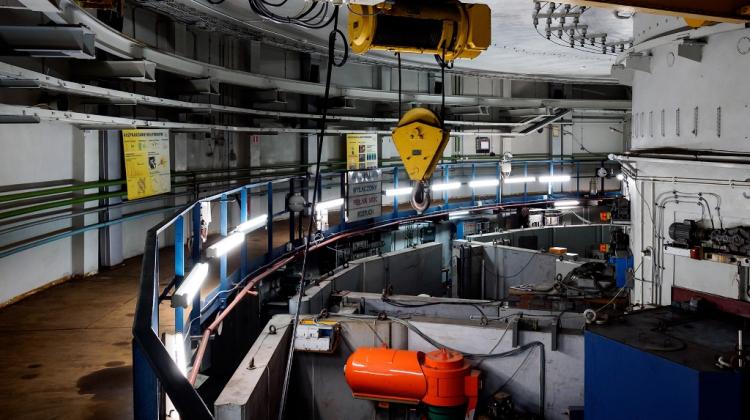MARIA reactor is not idle, taking advantage of new opportunities
 Maria reactor. Photo: PAP/ Tomasz Gzell 31.08.2011
Maria reactor. Photo: PAP/ Tomasz Gzell 31.08.2011
The reactor MARIA takes advantage of the opportunities that arise in Europe. Researchers from Świerk intend to take over the equipment from the decommissioned German reactor, and an important research project from the French - told PAP director of the National Centre for Nuclear Research, Prof. Grzegorz Wrochna.
"Maria is an excellent reactor, but has a relatively poor research equipment. In recent years, we placed emphasis on the production of radioisotopes for medical use and we have achieved a remarkable success in this field. But it is high time to develop the MARIA research program and equip it with better facilities" - said in an interview with PAP Prof. Grzegorz Wrochna, director of the National Centre for Nuclear Research (NCBJ), the operator of the MARIA reactor.
According to the Centre director, MARIA is now one of the four reactors in Europe and eight in the world that produce molybdenum-99 - radioisotope for medical use, used in 80 percent nuclear medicine procedures. Uranium discs are irradiated in the reactor and then processed. This produces molybdenum-99, which is then used to obtain technetium-99m. The latter radioisotope is a component of diagnostic kits used, among others, in the imaging of the brain, kidney, heart, bones. Wrochna revealed preparations were underway to allow MARIA to produce even more radioisotopes than before. Today radioisotopes created at NCBJ POLATOM go to 80 countries, and are used in over 2 million procedures annually.
Prof. Wrochna explained that the production of such radioisotopes is not possible in a nuclear power plant, only in a research reactor. "The reactor core at the nuclear power plant is enclosed in an airtight container, there is no possibility of inserting materials for irradiation" - he explained. Meanwhile, MARIA is a pool-type reactor - it is easy to place the necessary materials in its reservoir. In addition, nuclear reaction in Świerk does not occur without interruption, irradiation cycle lasts less than a week, after which the reactor operation is interrupted, and then researchers can access the pool and recover irradiated discs.
"On the one hand, the number of cancers increases, on the other hand, medicine is developing and demand for molybdenum-99 and other radioisotopes continues to grow. Ant the number of research reactors in the world, unfortunately, is not increasing" - admitted the scientist. According to him, this is associated with the negative attitude of society, especially in some countries, towards nuclear energy and all nuclear technologies. "But we use nuclear technology in many areas of life, not only in medicine and energy, but also in industrial procedures, protecting the borders, even in the study of works of art" - noted Prof. Wrochna.
The Centre director said that in France, due to changes in security requirements, the aging reactor Osiris is being decommissioned. Only in 2019 modern JHR will take over its functions. In Berlin, due to the policy of the German government the reactor BER II at HZB is being decommissioned.
The National Centre for Nuclear Research does not want to pass up the opportunities that appear in Europe. "BER II reactor has excellent research equipment, which is useless without the reactor. There is a chance that Świerk will be able to take over this equipment, worth approx. 200 million euros. We will have to bear some costs, but they represent only a few percent of the equipment value" - said the Centre director.
He explained that the equipment from Germany will be used for materials testing. It includes spectrometers and diffractometers. Prof. Wrochna explained that in the past, research with the use of this type of research reactors allowed, for example, to improve diesel engines. "Starting a diesel engine used to be a complex procedure. Now, you simply turn the key in the ignition and do not even think whether it is a diesel or not - engines are the same. All this thanks to research on the phenomenon of cavitation in the fuel carried out using neutrons from a reactor" - explained Wrochna. He added neutrons from a reactor also allowed to study the phenomenon of giant magnetic resistance, which is used in computer hard drives. Now, thanks to the equipment from Germany, research on unknown materials will also be possible in MARIA.
MARIA may also come to the aid of the French research programs at Osiris reactor, which will soon be closed. "In particular we are thinking about the MELODIE experiment" - said Prof. Wrochna. He explained that this project investigates the effects of radiation on various materials subjected, for example stress changes or stress. "We want an international team continue to research begun in the Osiris reactor. We\'re working on a probe that can be inserted into the reactor with test samples" - said the director.
"We are trying to take advantage of the opportunities that arise. Polish science is not as well funded as French or German science. We have smaller funds. But if the opportunity arises, why should we not grab large research programs and devices that cannot be used elsewhere? This will allow MARIA to become a key element of Europe\'s most important research programs" - concluded Prof. Wrochna.
PAP - Science and Scholarship in Poland, Ludwika Tomala
lt/ mrt/ zan/
tr. RL
Przed dodaniem komentarza prosimy o zapoznanie z Regulaminem forum serwisu Nauka w Polsce.


















